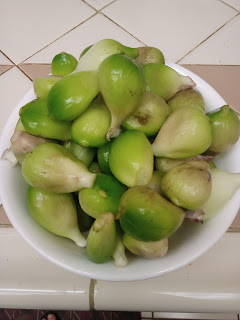 |
| Raw |
Water hyacinth is my new favorite local food. It's a water plant that grows in warm water, and is well known for how quickly it creates baby plants. In the past it has been used to pull toxins out of water sources, indeed, water purification is one of it's advantages. After I had added it to my pond the water instantly cleared and the fish became visible. Because the pond water is kinda yucky, I feel that water hyacinth should always be cooked, and I handle it like it's contaminated with E.coli (as it may be after the great manure spill of 2016).
According to Green Deane, the best way to eat water hyacinth is to stir fry, and I completely agree. With oil and garlic preferably. It has a taste not dissimilar from some good fresh green beans, which are hard to come by nowadays. The texture is decidedly different, as the air bulbs are crunchy and airy, like eating potato chips, and can be a bit chewy. Overall I would say that water hyacinth is quite palatable.
Water hyacinth is very different from other fruits and vegetables. Because it is so unusual I couldn't get the kids to try it, what a shame! It's so easy to grow in the pond - right plant, right space - that is seems to be ever bearing. Like ever bearing crunchy green beans! Even if the kids never eat it, I know I can eat it and the rabbits do quite enjoy the green bits (they won't eat the roots.)
This video talks a little bit about how water hyacinth is used at this lake to feed local livestock, including chickens.





.jpg)








